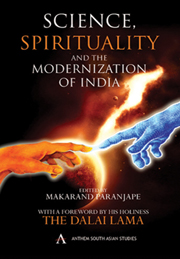Book contents
- Frontmatter
- Contents
- Notes on Contributors
- Foreword
- Editor's Preface
- I Science and Spirituality: East and West
- II Coming to Terms with Science: Some Change Agents
- III Building Bridges: Evolution, Consciousness and Healing
- CHAPTER 8 The Concept of the Yuga: Modern Scientific Approaches to Bridge Spiritual and Philosophical Concepts
- CHAPTER 9 Sri Aurobindo's Concept of Evolution of Consciousness: Exploration through the Paradigm of Health and Disease
- CHAPTER 10 The Blending of Science and Spirituality in the Ayurvedic Tradition of Healing
- CHAPTER 11 Micro-sensing by Indian Mystics
- CHAPTER 12 The Big Picture for the Science of Consciousness
- IV Science and Spirituality: Culture, Society and Gender
CHAPTER 10 - The Blending of Science and Spirituality in the Ayurvedic Tradition of Healing
from III - Building Bridges: Evolution, Consciousness and Healing
Published online by Cambridge University Press: 05 March 2012
- Frontmatter
- Contents
- Notes on Contributors
- Foreword
- Editor's Preface
- I Science and Spirituality: East and West
- II Coming to Terms with Science: Some Change Agents
- III Building Bridges: Evolution, Consciousness and Healing
- CHAPTER 8 The Concept of the Yuga: Modern Scientific Approaches to Bridge Spiritual and Philosophical Concepts
- CHAPTER 9 Sri Aurobindo's Concept of Evolution of Consciousness: Exploration through the Paradigm of Health and Disease
- CHAPTER 10 The Blending of Science and Spirituality in the Ayurvedic Tradition of Healing
- CHAPTER 11 Micro-sensing by Indian Mystics
- CHAPTER 12 The Big Picture for the Science of Consciousness
- IV Science and Spirituality: Culture, Society and Gender
Summary
This paper attempts to highlight the Ayurvedic tradition as a model that can serve as a platform to synthesize science and spirituality in the context of healing. Before venturing to examine this proposition, we need to understand the epistemological foundations of Ayurveda upon which a theoretical structure has been erected that encompasses the methods of both science and spirituality. As we proceed with this daunting task, we will realize the need to define and differentiate science and spirituality in the first place.
When we begin to familiarize ourselves with ancient methods of knowledge-building, the rigid compartments that dichotomize science and spirituality begin to dissolve. It becomes clear that the ancient knowledge systems did not profess such distinctions in the sense that we do today. What we encounter is a matrix in which these two approaches have blended naturally, so much so that it becomes difficult to distinguish between the two. It is when we impose our modern ideas of the scientific process and spiritual method that we are able to discover a theoretical framework that has fused these two seemingly conflicting approaches so spontaneously.
We have to discriminate between religion and spirituality to ward off misconceptions that may arise when we look at science and the scientific method. Religion is to spirituality what technology is to science. In other words, we can say that religion is the technology of spirituality.
- Type
- Chapter
- Information
- Science, Spirituality and the Modernisation of India , pp. 169 - 180Publisher: Anthem PressPrint publication year: 2009



